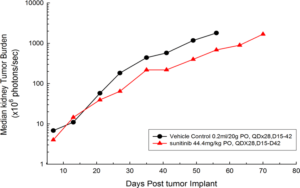786-O(PMMP-LUCNEO) - 肾细胞癌的模型
作者:
erin trachet,sr。科学顾问,肿瘤学/ sr.经理,提案开发
DATE:
September 2016
肾癌发生一般in older people, with an average age of diagnosis at 64 years old. Kidney cancer is among the ten most common types of cancer in the United States, with an overall lifetime risk of approximately 1.6 percent. The most common form of kidney cancer is renal cell carcinoma (RCC), representing 90-95 percent of all cases. Unfortunately, patients are asymptomatic until advanced stage of the disease, leaving them with limited treatment options. Given the poor prognosis, which is an eight percent 5-year survival rate for patients with advanced (stage IV) disease, predictive preclinical models are needed for reliably evaluating treatment options. While subcutaneous xenograft models are valuable, they fail to capture the complexity of the cancer growing in the tissue of origin. Orthotopic models provide an avenue for not only evaluating the treatment response, but also the impact on the origin tissue and tissue microenvironment-which can be critically important in trying to preserve kidney function.


In an effort to address this unmet need, Covance has developed an orthotopic RCC model, 786-O (pMMP-LucNeo) through implantation into the sub-renal capsule. This cell line has been transfected with luciferase, which allows for disease and response monitoring through bioluminescence imaging (BLI). In 786-O tumor bearing mice, we evaluated the anti-cancer activity of sunitinib. While treatment failed to produce clinically relevant activity, there was a measurable difference between the control and the sunitinib treated groups. Over time, we have found that the tumor growth of this model is reproducible and reliable, making it useful for testing novel therapeutics targeting RCC.


如果您有兴趣进一步讨论此模型,请与我们联系。
Note: Studies were performed in accordance with applicable animal welfare regulations in an AAALAC-accredited facility